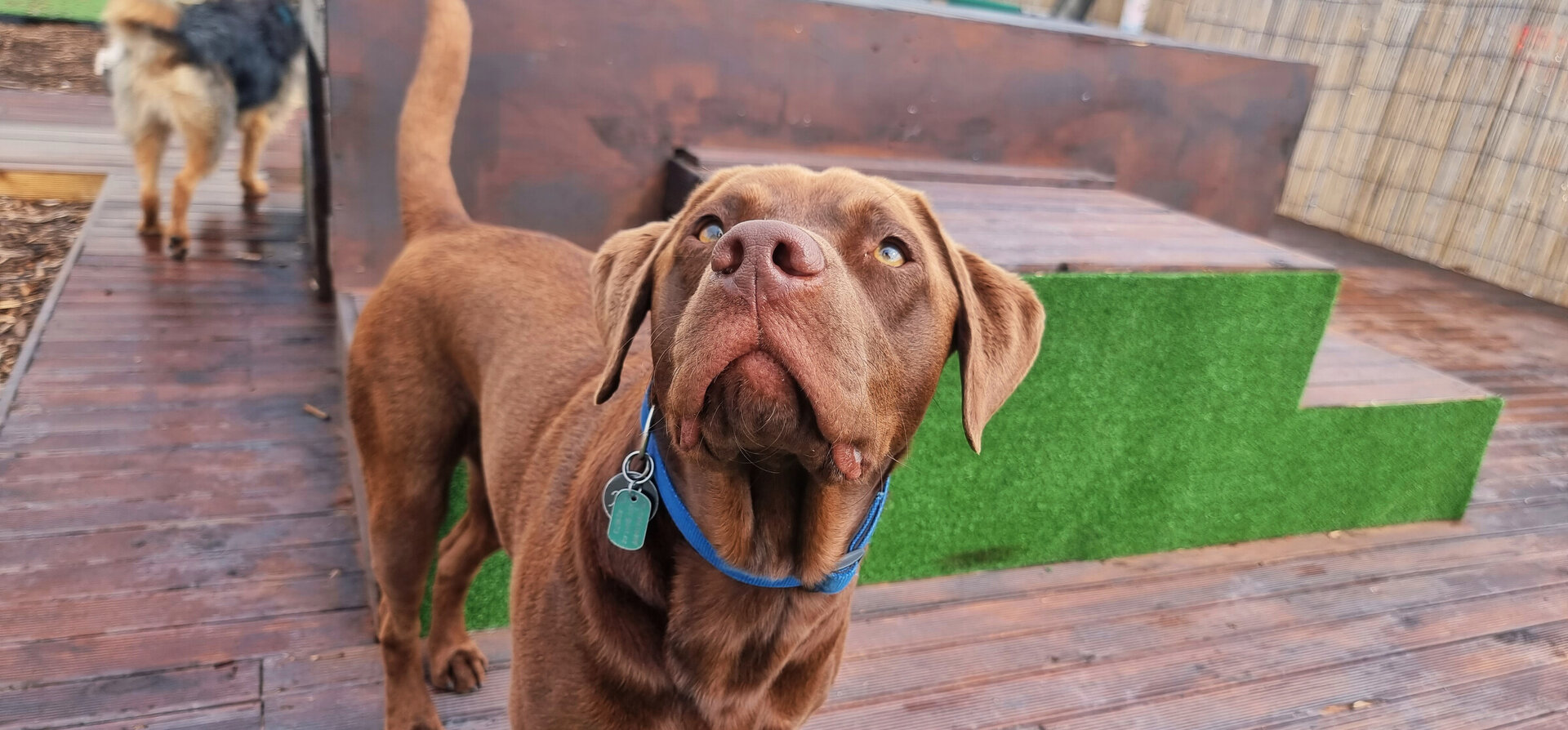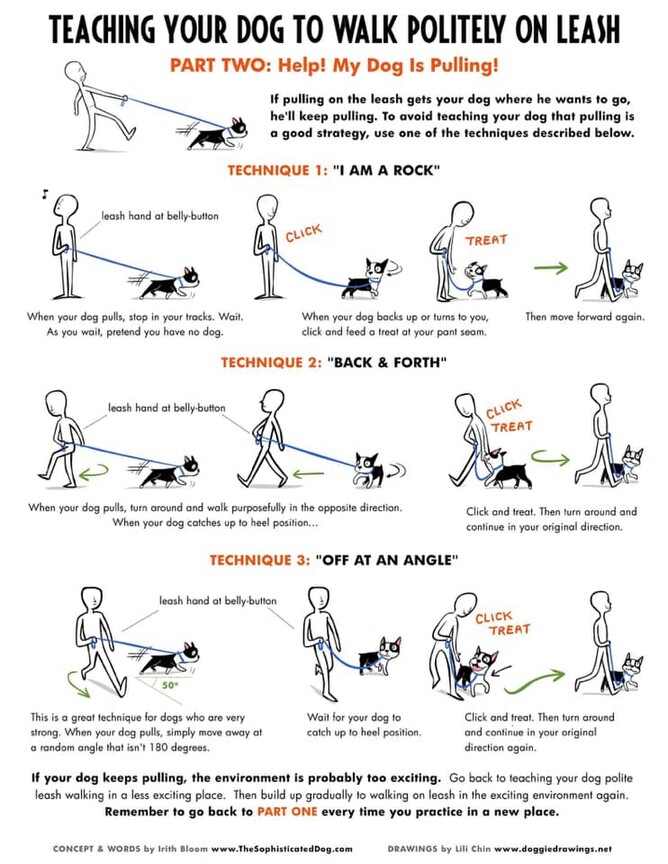One of the most common “basic” behavior issues that trainers are consulted for is pulling on the leash during walks. In this guide, we’ll go over WHY dogs pull as well as a few ways to teach your dog to walk nicely on lead.
NOTE: This guide is for dogs without other significant behavior issues like prey drive, chasing cars, or reactivity to dogs or people. This is only meant to solve general leash pulling.
Why Dogs Pull
Dogs pull when on leash for a multitude of reasons. Lets go over a few:
Dogs are not born understanding leashes. They dont know the purpose of them or associate that leash with a requirement to be a certain distance from the humans. This needs to be TAUGHT.
They want to go faster. A dog’s natural pace for traveling and exploring is usually much faster than a typical human’s walk. Especially if the walk is the only exercise they get, then they have all this pent up energy and moving at a walking pace is often not going to cut it.
There’s a thing to check out. Especially if a walk is the only real exercise and enrichment the dog gets during the day, it’s going to be very hard for them to resist checking out all of the neat things the wide world has to offer. The intense desire to get to that thing immediately can cause the dog to pull.
Pulling WORKS. As the dog pulls, the people move forward. Dogs are awesome at making simple associations. Pull = go forward. If I want to go, I gotta pull us there.
Note: NONE of these reasons include dominance, being “bad”, or being “stubborn”!
Equipment
There are a lot of things that are touted to help a dog walk nicely on a leash. While equipment should never be a substitute for training, sometimes it’s needed to help keep you and your dog safe. Here are a few I recommend, and a few that should be avoided:
YES: Harness. It’s a myth that harnesses cause a dog to pull. Instead, it’s far more likely that the discomfort of pulling on a collar inhibits the pulling. There are many different kinds of no-pull harnesses. Generally, you should look for one that has clips in the front (if the dog pulls) AND the back and that forms a “Y” shape over their chest, not straight across.
MAYBE: Flat Collar. A flat collar can be a good choice for a dog that already walks pretty nicely on a leash, but if the dog pulls strongly, they can do quite a bit of damage to the throat. Additionally, if a dog lunges, having their neck suddenly stop because of the collar can cause whiplash and other injuries.
MAYBE: Martingale Collar. A martingale collar is a collar that is loose and comfortable when the dog is at rest but tightens up around the neck when the dog pulls. These need to be fitted properly so that they only close enough that the dog cannot slip out and not enough to cause restriction to air or blood flow. They can be useful for a dog that is a flight risk, but should not be used for a dog that pulls on walks or has lunging for the same reason as a flat collar.
NO: Head Collar/Gentle Leader/Halti. These collars can be dangerous for dogs that are reactive or prey driven. One lunge and you can do major damage to the neck as the head gets constrained by the device. Generally, I dont recommend them unless there is nothing else that can help you be safe.
NO: Prong Collar. Prong collars are a type of “Aversive” training tool. They may stop a dog from pulling, but they do so using pain and fear of pain. It is never ok to intentionally cause a dog pain! The collar does NOT teach the dog to walk nicely on a leash and often has “side effects” such as increased stress hormone levels, increased stress behavior, increased reactivity, increased aggressiveness, and the risk for physical injury.
NO: Choke/Slip Collar/Chain. Not only is this an Aversive training tool like the prong collar, it also comes with some significant risk of injury. Unlike martingale collars, these have nothing to stop them from restricting blood and airflow to the dog. This can cause the dog long term injury and potentially increase the risk of stroke later in life. It can also cause a dog to panic and develop behavior issues from the trauma.
NO: Shock/Electronic Collar. For the exact same reasons as the prong collar. Not ok!
NO: Flexi/Retractable Leash. These provide constant tension that can result in encouraging a dog to pull. They also can be dangerous as a dog’s sudden lunge, potentially into traffic or danger, is usually faster than a human’s reaction time to stop the leash from allowing that distance. I have personally also seen quite a few bad rope burns/cuts on both dogs and people from mishaps. To top it all off, the handle is bulky and difficult to manage, especially during training. If it gets dropped and clatters on the pavement, that can be enough to spook a dog into darting into traffic or running away and getting lost.
Training a Loose Leash Walk
Training a dog to walk with a loose leash takes time and patience. Especially if the dog has been pulling for a while, it will take work to counter-act that.
Set your dog up for Success, NOT failure! If the dog pulls strongly the minute you get out the door, then start your practice indoors. We want the dog to succeed so that we can reward that success and build good habits!
Get some super tasty treats and get your fun face on! The goal is to teach the dog to WANT to walk nicely on a leash with you. Dogs learn best in a low stress and positive environment filled with motivation and encouragement rather than frustration and scolding and pain.
NEVER jerk on the leash, yell at, or punish your dog for pulling. Remember, they dont realize that it’s a bad behavior or that it is uncomfortable or painful for you. Punishing them during walks doesn’t solves the issue and can even create new ones!
Start in a low distraction environment like your driveway or yard. The more excited and distracted a dog is, the less likely they are going to be paying attention and learning the concept. Remember, set up for success!
Start with a SHORT leash. 4 feet or less is what I use for teaching loose leash walking. It’s hard to reward a dog that is 6-10 feet ahead of you. Also, the closer you are, the less likely that your dog will be distracted by other things. Keep them next to you, freedom to a longer leash can come later once they’ve learned the concept of keeping the leash loose.
This graphic provides a good method to start. Personally, I dont use a clicker but they can be very helpful for some people and their pups.
DON’T rush the training! Training needs to be taken at the dog’s pace. The dog should be challenged, but not put into a position that they are likely to fail in. Learning new habits takes time and building the difficulty of the exercise should be done gradually. Once, I didn’t leave my driveway for two weeks with a foster. Another time, I walked 2 miles in my driveway before we had achieved enough success to visit the neighbor’s mailbox.
Untraining Pulling
If a dog is already pulling on a leash, the best way to solve it is to remove the motivation and make it stop working to get the dog where they want to go.
There are a few methods to try as seen in this graphic:
Personally, I use Technique 2 mixed with Technique 3. I call it the “Crazy Lady” walk.
Basically I just go all over the place with frequent direction changes whenever the dog starts to pull and encourage the dog to follow me with praise and food.
Praise as soon as they turn from where they were going to start to follow you, then mark (with click or a “yes!”) reward when they get to you in a loose leash position.
Remember, dont rush it! Learning a new thing is difficult, especially when leashes have always been about pulling and excitement. Bad habits take time to undo! Taking that time now will be worth it in the long run!




